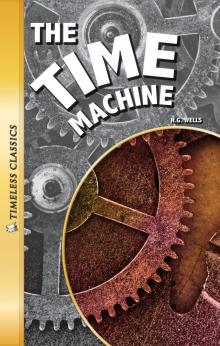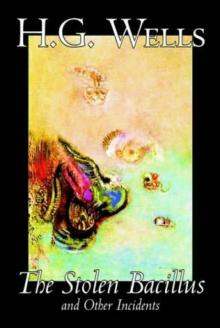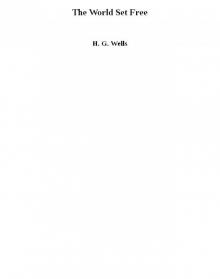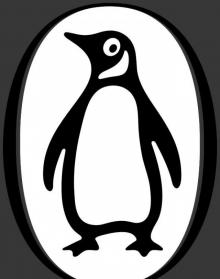- Home
- H. G. Wells
Time Machine and The Invisible Man (Barnes & Noble Classics Series)
Time Machine and The Invisible Man (Barnes & Noble Classics Series) Read online
Table of Contents
From the Pages of The Time Machine
From the Pages of The Invisible Man
Title Page
Copyright Page
H. G. Wells
The World of H. G. Wells, The Time Machine, and The Invisible Man
Introduction
The Time Machine - AN INVENTION
I
II
III
IV
V
VI
VII
VIII
IX
X
XI
XII
Epilogue
The Invisible Man - A GROTESQUE ROMANCE
I - The Strange Man’s Arrival
II - Mr. Teddy Henfrey’s First Impressions
III - The Thousand and One Bottles
IV - Mr. Cuss Interviews the Stranger
V - The Burglary at the Vicarage
VI - The Furniture That Went Mad
VII - The Unveiling of the Stranger
VIII - In Transit
IX - Mr. Thomas Marvel
X - Mr. Marvel’s Visit to Iping
XI - In the Coach and Horses
XII - The Invisible Man Loses His Temper
XIII - Mr. Marvel Discusses His Resignation
XIV - At Port Stowe
XV - The Man Who Was Running
XVI - In the Jolly Cricketers
XVII - Doctor Kemp’s Visitor
XVIII - The Invisible Man Sleeps
XIX - Certain First Principles
XX - At the House in Great Portland Street
XXI - In Oxford Street
XXII - In the Emporium
XXIII - In Drury Lane
XXIV - The Plan That Failed
XXV - The Hunting of the Invisible Man
XXVI - The Wicksteed Murder
XXVII - The Siege of Kemp’s House
XXVIII - The Hunter Hunted
The Epilogue
Endnotes
Inspired by The Time Machine and The Invisible Man
Comments & Questions
For Further Reading
From the Pages of The Time Machine
“Why should he not hope that ultimately he may be able to stop or accelerate his drift along the Time-Dimension, or even turn about and travel the other way?” (page 6)
There was a breath of wind, and the lamp flame jumped. One of the candles on the mantel was blown out, and the little machine suddenly swung round, became indistinct, was seen as a ghost for a second perhaps, as an eddy of faintly glittering brass and ivory; and it was gone—vanished! (page 9)
“As I put on pace, night followed day like the flapping of a black wing.”
(page 17)
“I saw great and splendid architecture rising about me, more massive than any buildings of our own time, and yet, as it seemed, built of glimmer and mist.” (page 18)
“Ages ago, thousands of generations ago, man had thrust his brother man out of the ease and the sunshine. And now that brother was coming back—changed!” (page 52)
“I grieved to think how brief the dream of the human intellect had been. It had committed suicide.” (page 70)
“Nature never appeals to intelligence until habit and instinct are useless.” (page 71)
The future is still black and blank—is a vast ignorance, lit at a few casual places by the memory of his story. (page 81—82)
From the Pages of The Invisible Man
The stranger was undoubtedly an unusually strange sort of stranger.
(page 101)
His goggling spectacles and ghastly bandaged face under the penthouse of his hat came with a disagreeable suddenness out of the darkness.
(page 107)
“I am just an ordinary man—a man you have known—made invisible.”
(page 161)
It was strange to see him smoking; his mouth, and throat, pharynx and nares, became visible as a sort of whirling smoke cast. (page 163)
“Just think of all the things that are transparent and seem not to be so.”
(page 172)
“So little suffices to make us visible one to the other.” (page 172)
“I beheld, unclouded by doubt, a magnificent vision of all that invisibility might mean to a man,—the mystery, the power, the freedom. Drawbacks I saw none.” (page 173)
“Alone—it is wonderful how little a man can do alone! To rob a little, to hurt a little, and there is the end.” (page 202)
BARNES & NOBLE CLASSICS
NEW YORK
Published by Barnes & Noble Books
122 Fifth Avenue
New York, NY 10011
www.barnesandnoble.com/classics
The Time Machine was first published in 1895.
The Invisible Man was first published in 1897.
Originally published in mass market format in 2003 by Barnes & Noble Classics
with new Introduction, Notes, Biography, Chronology, Inspired By,
Comments & Questions, and For Further Reading.
This trade paperback edition published in 2008.
Introduction, Notes, and For Further Reading
Copyright © 2003 by Alfred Mac Adam.
Note on H. G. Wells; The World of H. G. Wells, The Time Machine, and
The Invisible Man; Inspired by The Time Machine and The Invisible Man;
and Comments & Questions
Copyright © 2003 by Barnes & Noble, Inc.
All rights reserved. No part of this publication may be reproduced or
transmitted in any form or by any means, electronic or mechanical, including
photocopy, recording, or any information storage and retrieval system,
without the prior written permission of the publisher.
Barnes & Noble Classics and the Barnes & Noble Classics
colophon are trademarks of Barnes & Noble, Inc.
The Time Machine and The Invisible Man
ISBN-13: 978-1-59308-388-5 ISBN-10: 1-59308-388-2
eISBN : 978-1-411-43332-8
LC Control Number 2007941535
Produced and published in conjunction with:
Fine Creative Media, Inc.
322 Eighth Avenue
New York, NY 10001
Michael J. Fine, President and Publisher
Printed in the United States of America
QM
3 5 7 9 10 8 6 4 2
H. G. Wells
Social philosopher, utopian, novelist, and “father” of science fiction and science fantasy, Herbert George Wells was born on September 21,1866, in Bromley, Kent. His father was a poor businessman, and young Bertie’s mother had to work as a lady’s maid. Living “below stairs” with his mother at an estate called Uppark, Bertie would sneak into the grand library to read Plato, Swift, and Voltaire, authors who deeply influenced his later works. He showed literary and artistic talent in his early stories and paintings, but the family had limited means, and when he was fourteen years old, Bertie was sent as an apprentice to a dealer in cloth and dry goods, work he disliked.
He held jobs in other trades before winning a scholarship to study biology at the Normal School of Science in London. The eminent biologist T. H. Huxley, a friend and proponent of Darwin, was his teacher; about him Wells later said, “I believed then he was the greatest man I was ever likely to meet.” Under Huxley’s influence, Wells learned the science that would inspire many of his creative works and cultivated the skepticism about the likelihood of human progress that would infuse his writing.
Teaching, textbook writing, and journalis
m occupied Wells until 1895, when he made his literary debut with the now-legendary novel The Time Machine, which was followed before the end of the century by The Island of Dr. Moreau, The Invisible Man, and The War of the Worlds, books that established him as a major writer. Fiercely critical of Victorian mores, he published voluminously, in fiction and nonfiction, on the subjects of politics and social philosophy. Biological evolution does not ensure moral progress, as Wells would repeat throughout his life, during which he witnessed two world wars and the debasement of science for military and political ends.
In addition to social commentary presented in the guise of science fiction, Wells authored comic novels like Love and Mr. Lewisham, Kipps, and The History of Mister Polly that are Dickensian in their scope and feeling, and a feminist novel, Ann Veronica. He wrote specific social commentary in The New Machiavelli, an attack on the socialist Fabian Society, which he had joined and then rejected, and literary parody (of Henry James) in Boon. He wrote textbooks of biology, and his massive The Outline of History was a major international best-seller.
By the time Wells reached middle age, he was admired around the world, and he used his fame to promote his utopian vision, warning that the future promised “Knowledge or extinction.” He met with such preeminent political figures as Lenin, Roosevelt, and Stalin, and continued to publish, travel, and educate during his final years. Herbert George Wells died in London on August 13, 1946.
The World of H. G. Wells, The Time Machine, and The Invisible Man
1866 Herbert George Wells, known as a child as Bertie, is born on September 21 in Bromley, Kent. His pious parents, who had once been domestic servants, are often on the brink of financial ruin. Bertie’s father, now owner of a china shop, is an excellent cricket player but a bad businessman.
1871 Lewis Carroll’s Through the Looking-Glass and What Alice Found There is published. The first books of George Eliot’s Middlemarch are published. A British Act of Parliament legal izes labor unions. The Royal Albert Hall of Arts and Sciences opens in London.
1879 Wells’s mother takes work as a housekeeper at a nearby estate called Uppark, where she had served as a lady’s maid before her marriage. Bertie lives with her at Uppark, where he reads copi ously from the library.
1880 Bertie’s mother has him become an apprentice to a draper (a dealer in cloth and dry goods). He finds the work unsatisfying yet stays with this position and another for a pharmacist for the next two years.
1882 Charles Darwin dies.
1883 Bertie dislikes retail work and takes a position as an assistant teacher at Midhurst Grammar School. Robert Louis Steven son’s Treasure Island is published.
1884 Wells wins a scholarship and enters the Normal School of Sci ence in the South Kensington section of London. His mentor, the eminent biologist and proponent of Darwinism T. H. Hux ley, deeply influences him, introducing him to evolutionary sci ence and skepticism about human progress.
1887 The first Sherlock Holmes story, A Study in Scarlet, by Sir Arthur Conan Doyle, is published.
1888 Wells publishes sketches called The Chronic Argonauts that later
will become The Time Machine. He graduates from London University.
1891 He marries his cousin, Isabel Mary Wells. Oscar Wilde’s The Picture of Dorian Gray and Thomas Hardy’s Tess of the d‘Urbervilles are published.
1893 Wells’s marriage is unhappy. He falls in love with a beautiful young student named Amy Catherine (“Jane”) Robbins. His first published book, Textbook of Biology, appears. He becomes a full-time writer, known for independence of mind and works that challenge conventional thinking.
1895 After Isabel and H.G. divorce, he marries Jane Robbins. His tireless supporter, she types all of his manuscripts and corre spondence. Wells publishes The Time Machine, which parodies the English class system and provides a distressing view of the future of human society. The Stolen Bacillus, a collection of short stories, and The Wonderful Visit, a science-fiction novel, also appear. In his lifetime, Wells will publish more than eighty books.
1896 Wells publishes The Island of Dr. Moreau, in which a mad sci entist turns animals into semihuman creatures, and The Wheels of Chance, about the bicycling craze.
1897 The Faust-like tale The Invisible Man appears. Bram Stoker’s Dracula is published.
1898 Wells publishes The War of the Worlds, about an invasion of Martians.
1900 In the first years of the century, Wells and Jane host numerous luminaries in their home and actively engage in various politi cal and intellectual debates. Wells publishes a comic novel of lower-middle-class life, Love and Mr. Lewisham, about a strug gling teacher.
1901 A son, George Philip Wells, is born to Jane and H.G. The First Men in the Moon, which predicts human travels into outer space, and Anticipations, in which Wells advances his ideas about social progress, are published. Queen Victoria dies.
1903 A second son, Francis Richard, is born. Mankind in the Making, another book promoting social progress, is published. Wells joins the socialist Fabian Society, but soon draws fire from
George Bernard Shaw and others for his deviations from the Fabian line. Throughout his life, Wells takes every opportunity to share and implement his dream of a utopian society.
1905 Wells publishes the somewhat autobiographical comic novel Kipps: The Story of a Simple Soul, in which a man receives an unexpected inheritance. A Modern Utopia, again centered around Well’s ideas about social progress, also appears. George Bernard Shaw’s play Major Barbara is published.
1908 Wells resigns from the Fabian Society. He publishes The War in the Air, which foretells aerial combat.
1909 He publishes Tono-Bungay, a panoramic and critical picture of English society, and Ann Veronica: A Modern Love Story, a fem inist novel.
1910 Wells publishes an ode to the past in the comic novel The History of Mr. Polly, in which a shopkeeper changes his life. E. M. Forster’s Howards End appears.
1911 In The New Machiavelli, Wells excoriates the Fabian Society and provides portraits of its notable members. His collection The Country of the Blind and Other Stories appears.
1914 World War I begins. Wells and the writer Rebecca West, with whom he has a long affair, have a son, Anthony. Wells travels to Russia for the first time. He publishes The World Set Free, which predicts the use of the atomic bomb in warfare.
1915 Boon, a novel that satirizes Henry James’s style, is published under the pen name Reginald Bliss; it provokes an acerbic exchange between the two authors. D. H. Lawrence’s The Rainbow is published.
1916 Wells travels to the war fronts of Italy, Germany, and France. He publishes Mr. Britling Sees It Through, a realistic portrayal of the English during the war. James Joyce’s Portrait of the Artist as a Young Man is published.
1918 Wells creates anti-German information for the Ministry of Pro paganda.
1919 He coauthors, with Viscount Edward Grey, The Idea of a League of Nations.
1920 In an effort to rally supporters to his progressive political agenda, Wells travels again to Russia to meet with Lenin. Russia
in the Shadows and his immensely popular The Outline of History are published. Edith Wharton’s The Age of Innocence is published.
1922 A Short History of the World appears. T. S. Eliot’s The Wasteland is published. James Joyce’s Ulysses is published in Paris.
1927 Jane Wells dies. Virginia Woolf’s To the Lighthouse is published.
1928 Evelyn Waugh’s Decline and Fall appears.
1929 Wells publishes The Common Sense of World Peace.
1929 1930 In collaboration with his son, G. P Wells, and biologist Julian Huxley (grandson of T.H. Huxley), he publishes a work on biology called The Science of Life.
1930 W. H. Auden’s Poems is published.
1933 Wells publishes the novel The Shape of Things to Come, the story of a world war that lasts three decades in which cities are destroyed by aerial bombs.
1934 Wells travels to Moscow to speak with Stalin and returns
despondent over the encounter. The writer’s good-natured Experiment in Autobiography, a portrait of himself and his con temporaries, appears. He visits the United States and confers with Roosevelt.
1935 Based on the novel The Shape of Things to Come, Wells writes the screenplay for Things to Come, a film produced by Alexan der Korda and directed by William Cameron Menzies.
1936 Things to Come is released in the United States.
1938 Orson Welles’s radio broadcast of The War of the Worlds sends millions of Americans into panic.
1939 World War II begins.
1945 World War II ends. Wells publishes Mind at the End of Its Tether, a vision of mankind rejected and destroyed by nature. George Orwell’s Animal Farm appears.
1946 Herbert George Wells dies in London on August 13.
Introduction
Realist of the Fantastic
The Time Machine (1895) and The Invisible Man (1897) are now more than a century old. Yet they endure as literary texts, radio plays, and movies, because they appeal directly to two of our deepest desires: immortality and omnipotence. The time machine would allow us to escape death and gain knowledge of the fate of the earth, while invisibility would enable us to go and come as we please, under the noses of friends and enemies. At the same time, both fictions show us the dangers of fulfilled wishes: The Time Traveller discovers the future of humanity is not bright but hideously dark, while the Invisible Man drowns in the madness brought about by his own experimentation.

 Ann Veronica: A Modern Love Story
Ann Veronica: A Modern Love Story The Time Machine
The Time Machine The First Men in the Moon
The First Men in the Moon The Stolen Bacillus and Other Incidents
The Stolen Bacillus and Other Incidents The War of the Worlds
The War of the Worlds The Invisible Man: A Grotesque Romance
The Invisible Man: A Grotesque Romance The Island of Doctor Moreau
The Island of Doctor Moreau The Door in the Wall, and Other Stories
The Door in the Wall, and Other Stories The Best Science Fiction Stories of H G Wells
The Best Science Fiction Stories of H G Wells The Sea Lady
The Sea Lady The Wonderful Visit
The Wonderful Visit Love and Mr. Lewisham
Love and Mr. Lewisham Marriage
Marriage Tales of Space and Time
Tales of Space and Time The War of the Worlds (Penguin Classics)
The War of the Worlds (Penguin Classics) Twelve Stories and a Dream
Twelve Stories and a Dream The Food of the Gods and How It Came to Earth
The Food of the Gods and How It Came to Earth Tono-Bungay
Tono-Bungay The War in the Air
The War in the Air The Sleeper Awakes
The Sleeper Awakes The Country of the Blind and Other Stories
The Country of the Blind and Other Stories Kipps
Kipps The World Set Free
The World Set Free The Country of the Blind and other Selected Stories
The Country of the Blind and other Selected Stories Ann Veronica
Ann Veronica Ann Veronica a Modern Love Story
Ann Veronica a Modern Love Story The Time Machine and The War of the Worlds
The Time Machine and The War of the Worlds Time Machine and The Invisible Man (Barnes & Noble Classics Series)
Time Machine and The Invisible Man (Barnes & Noble Classics Series) The Time Machine and The Invisible Man
The Time Machine and The Invisible Man The Island of Dr. Moreau
The Island of Dr. Moreau Selected Stories of H. G. Wells
Selected Stories of H. G. Wells Island of Dr. Moreau
Island of Dr. Moreau THE NEW MACHIAVELLI
THE NEW MACHIAVELLI